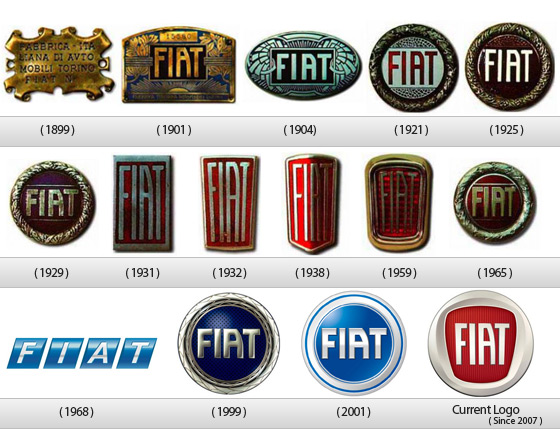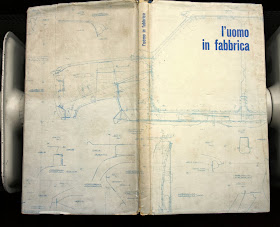L’uomo in fabbrica [Man in factory]
Publisher: Gruppo Fiat, Turin
Year of publication: 1971
Binding: hardcover (with paper dust jacket)
Size: 280 x 158 mm
Number of pages: 96
Number of illustrations: 92 black & white photographs; 12 color
Type of illustrations: documentary
Type of reproduction: offset
Photography: Aldo Moisio; Filiberto Rota; Enzo Isaia; e.g.
Text: Umberto Agnelli
Type: promotional book
Collection: Bart Sorgedrager, Amsterdam
In the publication L’uomo in fabbrica the automobile manufacturer Fiat expresses its affinity with its employees working on the shop floor, its focus on the importance of human workforce in factory work. A technical drawing of the Fiat 128 model is printed on the dust jacket. After a short introduction the book contains only photographs. A compilation of thumbnails, bleeding images and large images bordered with white bars show the reader a day at work in the factory. The variety in image size and the mixture of black & white and color photographs generate a dynamic flow in the visual narrative. The story begins with the employees going to work and it ends when they leave the Fiat complex; in addition, the storyline shows the fabrication of the Fiat 128. Captain of industry of the Fiat Group, Umberto Agnelli, is portrayed on the shop floor and wrote an introductory text.
For CEO’s Only is a selection of international company photobooks from the private collection of professional photographer Bart Sorgedrager, based in Amsterdam. Research assistant Clara Jankowski (MA Master Photographic Studies, Leiden University) has compiled a bibliography and captions for this particular selection of company photobooks and is presented in the exhibition as FOR CEO’S ONLY (alluding to the title of a company photobook by Richard Avedon for M&A Group in New York).
FIAT

Fabbrica Italiana Automobili Torino (FIAT) è stata fondata a Torino nel 1899 da un gruppo di investitori tra cui Giovanni Agnelli che più tardi divenne l’Amministratore Delegato della società. Per celebrare questo evento fu creato un manifesto e il nome della società in alto a sinistra del poster divenne il primo logo della società. Nel 1901 la società cambiò il suo logo con una lastra di ottone con il nome FIAT al centro. Nel 1925 il logo divenne circolare, rispetto alla forma ovale del 1904. La corona d’alloro attorno al cerchio era per celebrare la vittoria della società nella prima gara di auto a cui partecipò. La forma del marchio continuò a cambiare continuamente nel corso degli anni e ritornò alla forma circolare nel 1999. Il nuovo logo FIAT fu lanciato per la prima volta nel 2006 su una Bravo.
fiat 127 (1971) vs. fiat 127 concept
images courtesy david obendorfer
images courtesy david obendorfer
designed according to the stylistic canons of the 1970s, the resurrection of pio manzù’s fiat 127 is quite risky: the original model
was one of the first truly innovative cars of the 70s designed to be rational in style with clean volumes and pure, simple lines.
the danger of creating a car already seasoned at birth, as it were, with an imperceptible nostalgic effect is that it may not be
particularly attractive. with this being said, designer david obendorfer tries to unite the past and future in one car of updated
proportions and boasting with the unique combination forms influened by the model launched in 1971 with high-tech
solutions such as a multifunctional touch screen in the center of the dashboard.
was one of the first truly innovative cars of the 70s designed to be rational in style with clean volumes and pure, simple lines.
the danger of creating a car already seasoned at birth, as it were, with an imperceptible nostalgic effect is that it may not be
particularly attractive. with this being said, designer david obendorfer tries to unite the past and future in one car of updated
proportions and boasting with the unique combination forms influened by the model launched in 1971 with high-tech
solutions such as a multifunctional touch screen in the center of the dashboard.
enlarged in size compared to the original model, the fiat 127 concept is based on the fiat punto-alfa mito platform.
the minimalist
interior follows the same rational concept featuring nostalgic elements that give a strong personality to the dashboard. the circular
vents in the center, the chrome handles and the design of the two-spoke steering wheel are clear references to the first 127 model.






















Geen opmerkingen:
Een reactie posten